This article provides a comprehensive overview of various seborrheic dermatitis creams available today. Discussion not only includes a detailed review of each cream, but also provides the supplementary knowledge required to make more informed treatment decisions.
Due to the large number of creams available, the discussion is broken down into several key sections. Feel free to browse around as you wish or read in order; the content is organized as best as possible.
Introduction
In the search for the perfect seborrheic dermatitis cream, it is valuable to first understand both the fundamentals of seborrheic dermatitis and the principles used in the majority of cream formulations. Having this knowledge will allow you to make a more informed decision as to which cream to ultimately use.
Brief Review of Seborrheic Dermatitis
A tricky part of treatment is correct diagnosis. As there are several overlapping skin conditions that share similar features to seborrheic dermatitis (plaque psoriasis, rosacea, perioral dermatitis), ensuring you’re actually dealing with seborrheic dermatitis is the first essential step to successful treatment.
Seborrheic dermatitis is believed to be a chronic skin condition which requires ongoing maintenance treatment.
Primary Symptoms and Areas Affected
The primary symptoms include dryness, itchiness, skin flakes and scales, irritation, and inflammation. The severity of each of these symptoms varies from person to person, but dryness and flakes are present in most cases.
The most commonly affected areas of skin are the scalp and hairline, ears, eyebrows, nasal folds, melolabial folds (check creases), and chin. Out of these areas, the scalp is the single most problematic area for everyone affected, while the nasal folds appear to be where the majority of facial issues first appear.
If you would like to get a more in-depth understanding of basics of the condition and areas affected, please refer to the section.
Apparent Cause of Seborrheic Dermatitis Symptoms
The majority of medical literature on the subject agrees the following components are likely to be responsible for the majority of symptoms:
- Malassezia yeast – a common skin inhabitant proliferates aggressively and secretes oleic free fatty acids which irritate the skin and trigger unnecessary immune activation
- Alterted sebum composition – the oil-rich liquid our skin produces is lacking certain critical components to may typically prevent the aggressive proliferation of Malassezia or neutralize the oleic free fatty acids
- Individual sensitivity – though oleic free fatty acids are known to cause irritation for the majority of individual, the extent of irritation caused varies between individuals
Granted some disagreement exists and other possibilities have been put forward, this remains the primary understanding amongst the medical community. If you want to explore the cause of seborrheic dermatitis in more detail, the section provides more depth.
The Recommended Approach to Treatment
Though an estimated 1-5% of the population is affected by the condition [1] (the number is much higher specifically for scalp issues) there does not appear to be a definitive answer on how to best deal with it.
For the most part, dermatologists agree that suppressing the Malassezia yeast appears to provide the most direct route of treatment [2]. However, more recent literature questions this approach and theorizes that therapy that targets improvement of the skin barrier may be a more viable long-term approach [3].
Whatever the case may be, finding a suitable cream can be an essential step to keeping facial seborrheic dermatitis symptoms at bay (scalp application of cream is also possible, but can leave the hair quite greasy).
Brief Review of How Creams & Moisturizers Work
To give better context for the creams discussed in this article, it may be helpful to get a basic understanding of how creams and moisturizers work. Without going into excessive detail the majority of creams utilize the following components for their functionality:
- Moisturizing ingredients
- Anti-inflammatory agents
- Anti-oxidants
- Preservatives
Moisturizing Ingredients
The first component is one of the most straightforward. The majority of formulations typically utilize a variety of commonly used ingredients to provide a combination of several functional features:
- Occlusives – aid the moisture barrier and reduce TEWL (petrolatum, mineral oils, silicones, etc)
- Humectants – substances absorb water and help pull it into the skin (glycerin, propylene glycol, sodium PCA, urea, etc.)
- Emollients – help seal cracks in the skin and can have occlusive or humectant properties (cetyl alcohol, isopropyl myristate, ceramides, etc)
Taken together, these ingredients are the primary build blocks of basically any cream and moisturizer. Without them, you would lose the hydrating properties of the cream and only the other functional aspects of the formula would remain.
Anti-inflammatory Agents
Though corticosteroids are likely the most commonly prescribed anti-inflammatory agents, a variety of other ingredients have been shown to possess significant anti-inflammatory potential [4]. The benefit of using anti-inflammatory agents derived from natural plants and extracts, is they are usually void the rebound effect common to corticosteroid usage.
There are numerous ingredients that have shown to have potent anti-inflammatory properties. Some of the most common natural anti-inflammatory agents include:
- Aloe vera
- Bisabolol
- Shea butter
- Licorice extracts
- Niacinamide (vitamin B3)
And the list continues to grow as makers try to differentiate themselves from one another.
Since inflammation is such a major component of seborrheic dermatitis, creams with functional anti-inflammatory agents may be beneficial.
Anti-Oxidants
The inclusion of anti-oxidants in creams can serve a dual purpose. On the one hand, anti-oxidants can be beneficial for the skin and reduce the number of free radicals on the skin surface. On the other hand, they also help protect the other ingredients in the formulation from rapid oxidation.
The key to getting the most use of creams containing anti-oxidants is to use them a close to the production date as possible. This helps to ensure that the anti-oxidants themselves have not already done their job and will be utilized by the skin.
Popular anti-oxidants used in creams include:
- Vitamin C
- Vitamin E
- Grape seed extract
Preservatives
The primary ingredient in most creams and moisturizers is water. Unfortunately, this makes the product a perfect breeding ground for microbes and fungi. If creams did not have a functional preservative system in place, they would be unsafe for usage after only a few days of storage.
In order for a water-containing cream to survive, a preservative system is needed. The trouble here is that our skin is full of microbes and fungi that are important for its healthy function. This eco-system is known as the skin microbiome [5]. If the preservative system used in a cream is too aggressive, it may cause issues when it eventually interacts with the microbiome.
Out of all the components of a cream, the preservative system is likely to have the biggest influence on whether or not the user experiences a negative reaction [6].
Review of Potential Seborrheic Dermatitis Creams
Figuring out which creams to evaluate was probably the most difficult part of writing this post. The creams evaluated were chosen based on a mix of recommendations from community members, general popularity amongst seborrheic dermatitis sufferers, and my own personal experience.
The candidates include creams from several categories:
- Anti-fungal creams specifically marketed for seborrheic dermatitis treatment
- Barrier repair creams that help restore the skin’s natural defense system
- Common creams that have been reported to be effective
Though most medical literature evaluating seborrheic dermatitis treatments usually gives most attention to the first category, it’s been my experience that the other two categories can be just as (or even more so) effective.
Corticosteroid containing creams are excluded
Though corticosteroids containing creams are actively prescribed for the treatment of seborrheic dermatitis, long-term usage carries a significant risk of side-effects. Since seborrheic dermatitis treatment typically requires ongoing usage, many of the side-effects become hard to avoid and this severely offsets their short-term therapeutic benefits (except for HIV related seborrheic dermatitis) [7, 8].
Evaluation Criteria
In order to effectively evaluate the various seborrheic dermatitis creams available, it makes sense to establish a set of criteria that will be used. This will allow for a more fair and unbiased review of each formula.
The criteria defined here are based on my experience and knowledge. If using a different set of criteria, it’s likely that your favorite cream will differ.
Aggregate user feedback
In an effort to avoid bias, creams will be primarily judged on the aggregate user feedback found online via popular marketplaces. When such information is not available, personal experience and dedicated online review channels will be used.
Formula – Functional Ingredients Used
The skin care industry is known to add unnecessary ingredients simply for their marketing appeal. And this is particularly true for trending ingredients that are making headlines in various news syndicates.
Unfortunately, added ingredients can be counterproductive by introducing unwanted side effects. Plus, the more complicated a formula gets the higher the probability of unknown cross-reactions between individual components.
Formula – Preservative System Used
Any time a cream contains water, a preservative system is required to ensure adequate shelf life. Unfortunately, many commonly used preservatives are known to irritate sensitive and/or damaged skin [6]. Creams that use a preservative system that is known to have a high chance of causing irritation will be ranked lower.
Formula – Chance of Irritation
Tied directly into the previous criteria (the preservative system used) all other ingredients of the formula will be briefly evaluated for their chance to cause irritation.
However, please keep in mind that it’s difficult to obtain such information for many of the new ingredients being introduced today. As a result, this criteria will be largely based on specific evaluation of the aggregate user feedback.
Formula – Absorption Rate
If a cream isn’t absorbing well, you may find yourself with a thick layer of build-up. Not only is this not pleasant esthetically, but it may also have a negative effect on the efficiency of the active ingredients. For a cream to absorb well, it needs the right mix of oils, without going overboard on the heavier occlusives (such as petrolatum).
Formula – Proportion of Natural Ingredients
Though natural does not always mean better, many users prefer natural skin care ingredients in an effort to reduce unknown long-term implications. Naturally, many of us believe that if something is found in nature, there’s a less chance that it will harm us.
Cost – Real world usage cost
There are some effective seborrheic dermatitis creams that make regular usage unrealistic as they simply cost too much. Though the may be a good option for those with enough finances to pay for them, they are unlikely to benefit the large majority of seborrheic dermatitis affected individuals.
The cost will be considered based on how much cream is actually required per treatment and how often they need to be used.
Availability
Some creams and moisturizers listed here can be hard to obtain. This can be the result of a prescription requirement or simply due to limited availability across the country. Though this rating factor is not included for each option (majority have average availability), it is highlighted when availability is limited.
Anti-fungal/Medicated Creams
Anti-fungal creams aim to tackle seborrheic dermatitis head-on by reducing the mycotic (fungal) activity of the skin’s microflora. And since Malassezia is believed to be at the heart of seborrheic dermatitis symptoms, this is the most common approach taken by dermatologists.
The anti-fungal creams listed here are available over the counter without the need for a prescription. There are stronger alternatives available, but these require a prescription from a medical professional and are usually only required in difficult to treat cases.
If you feel I’ve missed any products, please drop a note in the comments section at the bottom of this post. Will try my best to keep this list current and up-to-date.
Noble Formula Zinc Pyrithione Cream Zinc Pyrithione Cream for Seborrheic Dermatitis
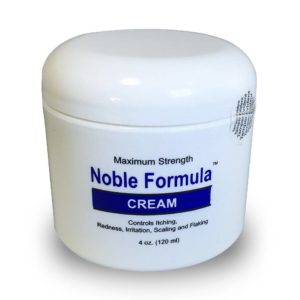
Pyrithione Zinc (.25%),Purified Water, Almond Oil, Squalane, Cyclomethicone, Rose Hip Oil, Arachidyl Behenyl Alcohol, & Archidyl Glucoside (a naturally derived emollient), Natural Vitamin E (d-Alpha-Tocopherol), Cetearyl Alcohol, Cetearyl Alcohol Glucoside, Sodium Laurel Sulfate, Sodium Hydroxymethylglycinate (an amino acid derivative), and TEA-Carbomer
A fairly simple cream formula supplemented with medically proven anti-fungal agent zinc pyrithione. Though it is has a strong Amazon rating, a subset of individuals have reported results can diminish and seborrheic dermatitis issues can return even with continued usage (my experience was similar).
Investigation of the ingredients also leaves some unanswered questions. For example, why did the makers choose to integrate sodium laurel sulfate? And why use a jar, when a more effective container can reduce the necessity of a stronger preservative?
Sodium lauryl sulfate is a popular surfactant (used to clean skin) with a poor reputation [9]. And the majority of formulations targeted at treating sensitive skin typically try to avoid this ingredient due to its irritation potential (being a leave-on product, the irritation potential of this ingredient is further increased). It’s possible that this sole ingredient is responsible for the negative reaction some individuals have reported.
Additionally, the chosen preservative (Sodium Hydroxymethylglycinate) does not have the best safety rating. Would be great if they went with something more gentle and chosen different packaging to limit exposure (being in a jar that you dip your finger into increases the requirement for a strong preservative to be used).
DermaZinc Zinc Pyrithione Cream Alternate Zinc Pyrithione Cream for Seborrheic Dermatitis
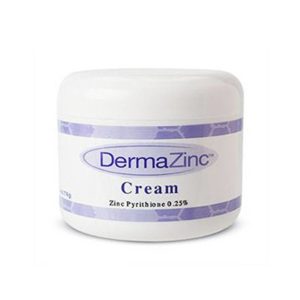
Active Ingredients: Zinc Pyrithione 0.25%. Inactive Ingredients: Purified Water (Aqua), Stearic Acid, Glycol Stearate, Isopropyl Palmitate, Mineral Oil, Aloe Vera, Triethanolamine, Cetyl Alcohol, Carbomer, DMDM Hydantoin, PEG-75 Lanolin, Methylparaben, Tocopherol Acetate, Dimethicone, Undecylenic Acid, Sodium Lauryl Sulfate
Another popular seborrheic dermatitis cream utilizing zinc pyrithione as the active anti-fungal agent.
Overall it’s very similar to the first zinc pyrithione cream introduced (Noble Formula). The biggest differences are the lack of vegetable oils (replaced by mineral oil and stearic acid) and paraben based preservative system (again very aggressive).
If having to choose between the two options (Noble Formula and DermaZinc), the prior formulation will likely take the edge due to it’s more mild approach. However, both could benefit from a more gentle preservative system and reduction of unnecessary additions.
The inclusion of this was formula was primarily to highlight the fact that other options for each cream typically exist. Due to variation in availability, pricing, and the overall formulation it makes sense to evaluate some of the other options available. For the rest of this article, alternate options will be included directly below the primary candidate reviewed.
MG217 Psoriasis Treatment 2% Coal Tar Ointment Coal Tar Cream for Seborrheic Dermatitis
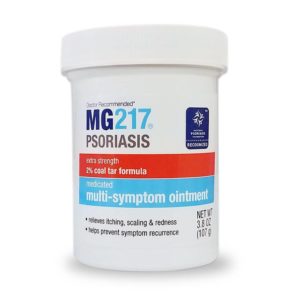
Coal Tar 2% (from Coal Tar Topical Solution, USP 20%), petrolatum, cetyl alcohol, polysorbate 80, microcrystalline wax
A simple formula primarily marketed for psoriasis, but also known to be effective for seborrheic dermatitis symptoms. The formula utilizes the time-tested active ingredient, coal tar [10, 12].
The reviews across the internet for this formula are quite good, with the large majority praising its effectiveness to calm the redness and reverse the symptoms of plaque psoriasis. Though the feedback specifically for seborrheic dermatitis is limited, satisfied users do exist.
The ingredients list is short and simple. There is no water present, so a preservative system is not needed. And since the formula utilizes petrolatum as the primary humectant, a little will go a long way.
From my point of view, the biggest negative is the active ingredient (coal tar) gives off quite a strong odor and can give the skin a darker tone.
Overall the formula has a lot going for it. If you can get past the odor and color, then this is definitely a strong contender you should consider.
Alternative Coal Tar Creams for Seborrheic Dermatitis
Coal tar is one of the oldest medicated options that have made this list. Since it is commonly used for psoriasis treatment, a variety of options are available [12].
Alternatives include:
- Dermarest Psoriasis Medicated Moisturizer
Ingredients: Water, Caprylic/Capric Triglyceride, Mineral Oil, Sodium Citrate, Cetyl Alcohol, Butylene Glycol, Stearic Acid, Polysorbate 60, Glyceryl Stearate, Carbopol Ultrez, Zinc PCA, Panthenol, Camellia Sinensis Leaf Extract, Algae Extract, Artemisia Vulgaris Extract, Dipotassium Glycyrrhizate, Rheum Palmatum Extract, Carthamus Tinctorius (Safflower) Flower Extract, Rosa Damascena Extract, Triethanolamine, Disodium Edta, Methylparaben, Propylparaben, Dimethicone, Dmdm Hydantoin, Kukui Nut Oil - Creme Classique Coal Tar Cream
Ingredients: Aqua (Water), Ceteareth-20, Cetearyl Alcohol, Coal Tar (6%), Imidiazolidinyl Urea, Methylparaben, Paraffinium Liquidum (Mineral Oil), Petrolatum, Propylparaben, Triclosan 2%
Sebclair Dermatola Cream (Promiseb Topical Cream) Piroctone Olamine Cream Seborrheic Dermatitis
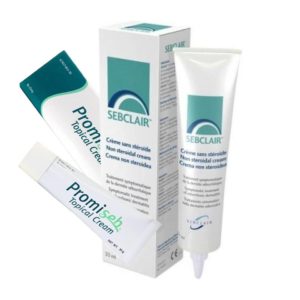
Aqua, Isohexadecane, Butyrospermum parkii (Shea butter), Pentylene glycol, Ethylhexyl palmitate, Ceraalba, PEG-30 dipolyhydroxystearate, Bisabolol, Polyglyceryl-6 polyrycynoleate, Tocopheryl acetate, Hydrogenated castor oil, Lactic acid, Solanum lycopersicum (tomato?), Citrus limonum, Vaccinum myrtilus, Citric acid, Malic acid, Allantoin glycyrrhentinic acid, Butylene glicol, Magnesium sulphate, Piroctone olamine 1%, Magnesium stearate, Disodium EDTA, Vitis vinifera, Ascorbyl tetraisopalmitate, Propyl gallate, Telmesteine.
This one may create confusion as it goes under two different names depending on where you are located. In Europe, it is more commonly sold under over the counter under the brand name Sebclair Dermatola Cream. However, in North America, it is usually sold under the name Promiseb Topical Cream.
Though it’s difficult to determine the exact reason for this difference, it’s likely related to the fact that the active ingredient of the formula is still awaiting FDA approval. Thus, in North America, a prescription is required for its off-label use.
Whatever the case may be, the formulation has been shown to be effective for the treatment of seborrheic dermatitis [13] and Sebclair is marketed as a non-steroidal cream for the treatment of seborrheic dermatitis (in North America, the wording is a little different).
It contains the active ingredient piroctone olamine, which is an anti-fungal agent commonly used in Europe. From a quick review, the anti-fungal potential of piroctone olamine appears to be similar to ketoconazole [14]. However, it’s usage and popularity remains limited in North America due to pending FDA approval.
What pending FDA approval means
Though there are numerous formulations that contain piroctone olamine available for purchase without a prescription, they are not legally allowed to be labeled as anti-dandruff or mention the treatment of seborrheic dermatitis. Thus, in North America usage of these options is considered “off-label” until the FDA moves forward with its decision.
The rest of the ingredients of the Sebclair cream are aimed to help the skin retain moisture and possibly improve barrier function. Isohexadecane and shea butter appear to be the primary occlusives used, while the pentylene glycol pulls moisture into the skin.
The other area this cream appears fairly heavy on is the use of anti-inflammatory agents. Bisabolol (extracted from the essential oil of chamomile) takes the lead characteristics [15], with vitamin E (in the form of Tocopheryl Acetate), alglycera [13], and telmesteine (an agent used more commonly used for respiratory tract disorders[16]) providing additional support.
Overall, it’s great that many of the ingredients in this formulations are derived from nature and it does not just depend solely on the anti-fungal agent used. Interestingly, I wasn’t able to pinpoint the preservative system used here, but it’s possible that the piroctone olamine itself serves a dual role, both as the active ingredient and the preservative system.
Alternative Piroctone Olamine Creams for Seborrheic Dermatitis
Since piroctone olamine is not officially approved by the FDA for seborrheic dermatitis treatment, the number of options available in North America is limited. However, it seems that piroctone olamine is allowed for use and may be found as part of the active preservative system in a general moisturizing cream (one example is the new Eucerin formula). Regardless, the best availability remains limited to countries outside of North America.
Other creams that contain piroctone olamine include:
- Eucerin Skin Calming Natural Oatmeal Enriched Creme (Red Cap Formula – See Notes Later in Article)
Ingredients: Water, Glycerin, Cetyl Palmitate, Mineral Oil, Caprylic/Capric Triglyceride, Octyldodecanol, Cetyl Alcohol, Glyceryl Stearate, Colloidal Oatmeal, Dimethicone, Methylpropanediol, PEG-40 Stearate, 1,2-Hexanediol, Phenoxyethanol, Piroctone Olamine, Carbomer, Benzyl Alcohol, Polyglyceryl-2 Caprate, Decylene Glycol - La Roche Posay Kerium DS (Not Sold in North America)
Ingredients: Aqua / Water Isononyl Isononanoate Glycerin Dimethicone Ammonium Polyacryldimethyltauramide / Ammonium Polyacryloyldimethyl Taurate Myristyl Myristate Stearic Acid Potassium Cetyl Phosphate Zinc PCA Glyceryl Stearate Se Sodium Hydroxide Palmitic Acid Disodium Edta Capryloyl Glycine Vitreoscilla Ferment Citric Acid Xanthan Gum Acrylates Copolymer Sodium Benzoate Phenoxyethanol Piroctone Olamine Parfum / Fragrance
Family Care Clotrimazole Anti-Fungal Cream Clotrimazole Cream Seborrheic Dermatitis
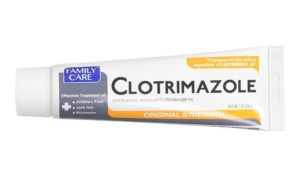
Active Ingredients: Clotrimazole 1%. Inactive Ingredients: 2-octyldodecanol, benzyl alcohol, cetaryl alcohol, cetyl esters, monobasic sodium phosphate dihydrate, polysorbate 60, propylene glycol, purified water, sorbitan stearate
Clotrimazole is one of the most popular anti-fungal agents for the treatment of seborrheic dermatitis. Though it appears to inferior to Ketoconazole, it is commonly prescribed by dermatologists and doctor and several over the counter options are also available in some countries. Family Care Clotrimazole Cream is one of these options and contains 1% clotrimazole as the active anti-fungal ingredient.
The ingredients list does leave a lot of room for improvement as several of the featured ingredients are commonly known irritants for individuals with sensitive skin. For example, benzyl alcohol has been reported to be problematic for individuals with sensitive skin [17] and similar reports exist for polysorbate 60 [18].
Overall, with minimal usage and careful spot testing, this may be a good choice for many individuals. Alternatively, you can probably discuss other clotrimazole ointments with your dermatologists if you suspect sensitive to one of the ingredients present.
Curad Silver Solution Antimicrobial Gel Silver Nanoparticles for Seborrheic Dermatitis
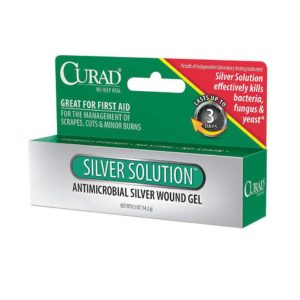
Active Ingredients: Silver Chloride (55ppm). Inactive Ingredients: Carbomer, Glycerin, Sodium Chloride, Triethanolamine, Water
This gel was first brought to my attention by a passing reader. He noted that it was the only thing that proved effective for him after a long and painful experimentation process with many of the other options described here.
The formulation utilizes silver chloride as the active ingredient. Though silver chloride is officially considered an antimicrobial agent (with activity against microbes and not fungi), medical research suggests that it posses potent anti-fungal activity [19, 21, 21].
A minimal ingredients list is a welcome sight. Only the needed basics are used and the efficiency of the silver chloride as both an anti-fungal and antibacterial agent (in addition to low the water content) allow the formula to do without an added preservative system. Plus, the usage of glycerin, as opposed to the less expensive propylene glycol, is an added bonus.
The Ordinary Azelaic Acid Suspension Azelaic Acid Cream for Seborrheic Dermatitis
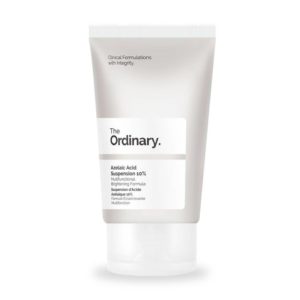
Aqua (Water), Isodecyl Neopentanoate, Dimethicone, Azelaic Acid, Dimethicone/Bis-Isobutyl PPG-20 Crosspolymer, Dimethyl Isosorbide, Hydroxyethyl Acrylate/Sodium Acryloyldimethyl Taurate Copolymer, Polysilicone-11, Isohexadecane, Tocopherol, Trisodium Ethylenediamine Disuccinate, Isoceteth-20, Polysorbate 60, Triethanolamine, Ethoxydiglycol, Phenoxyethanol, Chlorphenesin.
Though azelaic acid is not technically considered a primary treatment choice for seborrheic dermatitis, it has shown to be effective in both acne and rosacea treatment [22, 23]. Because of its value in these two similar skin conditions, some researchers have begun to evaluate its usage for seborrheic dermatitis treatment [24].
Online feedback regarding the usage of similar azelaic acid creams (for seborrheic dermatitis) appears to support this and a long-form Reddit comment from a sufferer of several decades outlines it’s potential in great detail (he uses a 20% cream).
Malassezia themselves produce azelaic acid
Interestingly, azelaic acid is also produced by Malassezia yeasts themselves as a defense mechanism against other bacteria/fungi. Could using their own weapon against them get any more genius?
The ingredients of the Ordinary Azelaic Acid cream are a little complex on paper and many new ingredients (with limited information) are used. This makes analysis a difficult endeavor. Dimethicone (a silicone) appears to be the primary occlusive used and there are no natural oils present (for those actively trying to avoid using oils on seborrheic dermatitis affected skin).
Barrier Repair Creams
Anti-fungal preparations appear to be the primary treatment approach recommended by the majority of medical literature [25, 1] and experienced dermatologists. However, it appears that focusing on improving the skin’s own barrier function may warrant more investigation.
Though this subject has limited research, more recent literature points to the potential of treatments that target correcting barrier deficiencies. For example, a 2015 review paper on seborrheic dermatitis [26] highlighted two specific papers that pointed to barrier defects as core elements of seborrheic dermatitis:
- Genetic investigation showed a possible connection to a mutation in specific skin cells [27]
- In individuals susceptible to seborrheic dermatitis the skin was seen to have an altered profile of protein, ceramides, and free fatty acids; even when symptoms were in remission [28]
In conclusion, the review paper noted that these studies emphasize the importance of barrier repair in the treatment of seborrheic dermatitis.
Additionally, the title of the following paper summarizes this important feature of the skin condition more effectively:
- Dandruff: a condition characterized by decreased levels of intercellular lipids in scalp stratum corneum and impaired barrier function – by CR Harding – 2002 [29]
Now if we consider barrier abnormalities integral to the progression of seborrheic dermatitis, it’s puzzling that many of the most common treatment choices easily take this for granted and hardly ever optimize their formulations for barrier repair.
When we look at studies that evaluate the effectiveness of focusing on barrier repair in the treatment of seborrheic dermatitis, we see that this approach may in-fact be rewarding. And the most notable target appears to be glycerin.
Glycerin (also known as glycerol) is an important component of healthy skin and defects in its availability have long been associated with defects with the skin’s moisture barrier and dry skin conditions [30]. Topical application of glycerin has been shown to assist in correcting these abnormalities and help restore barrier stability [31]. Investigation of the usefulness of glycerin of seborrheic dermatitis, demonstrated that a cream high in glycerin “can have a significant impact on the dandruff condition” and reasoned that addressing the quality of the stratum corneum (top layer of skin) may result in a reduction of seborrheic dermatitis symptoms [25].
Though additional investigation into the realm of barrier repair formulations for the treatment of seborrheic dermatitis appears to be lacking (except for the usage of borage oil for infantile seborrheic dermatitis [32, 33]) is lacking, I strongly believe that focusing on this aspect of the condition can be rewarding.
Accordingly, this section evaluates some of the more popular barrier repair creams for seborrheic dermatitis treatment.
Cetaphil Pro Eczema Soothing Moisturizer Over The Counter Barrier Repair Cream for Seborrheic Dermatitis
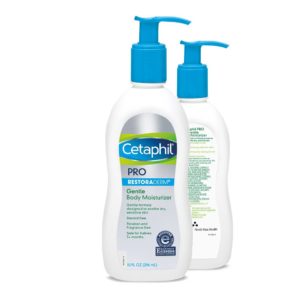
Water, Glycerin, Caprylic/Capric Triglyceride, Helianthus Annus (Sunflower) Seed Oil, Pentylene Glycol, Butyrospermum Parkii (Shea Butter), Sorbitol, Cyclopentasiloxane, Cetearyl Alcohol, Behenyl Alcohol, Glyceryl Stearate, Tocopheryl Acetate, Hydroxypalmitoyl Sphinganine, Niacinamide, Allantoin, Panthenol, Arginine, Disodium Ethylene Dicocamide PEG-15 Disulfate, Glyceryl Stearate Citrate, Sodium PCA, Ceteareth-20, Sodium Polyacrylate, Caprylyl Glycol, Citric Acid, Dimethiconol, Disodium EDTA, Sodium Hyaluronate, Cetyl Alcohol.
Cetaphil is one of the best selling skin care lines for individuals with sensitive skin. Unlike the anti-fungal creams described above, this formulation does not appear to have any single active ingredient responsible for its effectiveness. Instead, the formula depends on a combination of ingredients known to improve skin barrier function.
From an investigation of the ingredients, the formula appears to have a heavy focus on improving skin moisture levels with a balance of known ingredients. Glycerin, Pentylene Glycol, sorbitol, sodium PCA, and Sodium Hyaluronate appear to be the primary humectants (drawing moisture into the skin), while Caprylic/Capric Triglycerides and shea butter are the primary occlusives (sealing in the moisture).
In terms of preservatives, the formula like depends on a combination of lower water potential (ability for germs to use the present water) and caprylyl glycol (an anti-microbial). If this is the case, the preservative system is well selected and one of the more green approaches currently used in the cosmetic industry.
Though I’ve made attempts to steer away from personal experiences in the writing of this article, this lotion was one of the most effective off-label seborrheic dermatitis treatments I’ve ever tried. For a period of roughly 1 year, once a day usage of this lotion together with the cleanser eliminated my symptoms better than anything else I had attempted prior to its usage. Once I had shared my approach on this website, many other readers have successfully utilized this approach as well.
Cetaphil keeps changing the name
Over the years, have seen this same formula sold under the several different names. If you can’t find the formula under the name listed here, please leave a comment below and will make sure to update the article accordingly.
Additional Over the Counter Barrier Repair Creams for Off-Label Seborrheic Dermatitis Treatment
Many producers are now aware that assisting barrier repair should be one of the most important goals for a solution designed to combat dry flaky skin. As a result, many formulations are now carefully crafted with this as their primary aim.
Some other popular barrier repair formulations include:
- CeraVe Moisturizing Cream
Ingredients: Purified Water, Glycerin, Ceteareth-20 And Cetearyl Alcohol, Caprylic/Capric Triglyceride, Behentrimonium Methosulfate And Cetearyl Alcohol, Cetyl Alcohol, Ceramide 3, Ceramide 6-II, Ceramide 1, Hyaluronic Acid, Cholesterol, Petrolatum, Dimethicone, Potassium Phosphate, Dipotassium Phosphate, Sodium Lauryl Lactylate, Disodium Edta, Phenoxyethanol, Methylparaben, Propylparaben, Phytosphingosine, Carbomer, Xanthan Gum - First Aid Beauty Ultra Repair Cream Intense Repair
Ingredient: Water, Stearic Acid, Glycerin, C12-15 Alkyl Benzoate, Caprylic/Capric Triglyceride, Glyceryl Stearate Se, Glyceryl Stearate, Cetearyl Alcohol, Butyrospermum Parkii Butter, Dimethicone, Squalane, Allantoin, Camellia Sinensis Leaf Extract, Caprylyl Glycol, Ceramide 3, Chrysanthemum Parthenium Extract, Colloidal Oatmeal, Disodium EDTA, Eucalyptus Globulus Leaf Oil, Glycyrrhiza Glabra Root Extract, Sodium Hydroxide, Xanthan Gum, Phenoxyethanol.
Gold Bond Ultimate Healing Skin Therapy Lotion Simple Moisturizer for Seborrheic Dermatitis
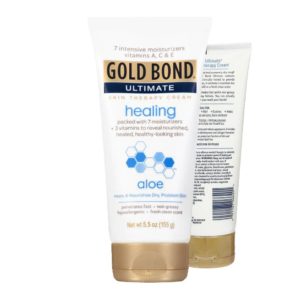
Water, Glycerin, Dimethicone, Petrolatum, Jojoba Esters, Cetyl Alcohol, Aloe Barbadensis Leaf Juice, Stearyl Alcohol, Distearyldimonium Chloride, Cetearyl Alcohol, Steareth-2, Steareth-21, Propylene Glycol, Chamomilla Recutita (matricaria) Flower Extract, Polysorbate 60, Stearamidopropyl Pg-dimonium Chloride Phosphate, Methyl Gluceth-20, Tocopheryl Acetate, Magnesium Ascorbyl Phosphate, Hydrolyzed Collagen, Hydrolyzed Elastin, Retinyl Palmitate, Hydrolyzed Jojoba Esters, Glyceryl Stearate, Edta, Fragrance, Potassium Hydroxide, Diazolidinyl Urea, Methylparaben
Using this specific cream for seborrheic dermatitis first came on my radar thanks to a YouTube video uploaded by RDKamikaze. He described having to deal with the condition for a long time trying various treatment approaches until he was finally able to get things under control with the off-label use of this simple cream.
A fine line between barrier repair creams and moisturizers
Though it is not technically sold as a barrier repair cream, it has been included in this section based on the formulas inclusion of collagen, elastin, and glycerin. Some literature suggests that well simply well-formulated moisturizers can be as effective as prescription barrier repair creams [34].
Feedback from other users has been mixed, but positive experiences appear to take the lead. And though reviews of it’s usage for seborrheic dermatitis treatment are limited, you can definitely find a few scattered around the web.
Overall the ingredients list is representative of a good moisturizer with several items known to benefit barrier stability. The primary humectant is glycerin, but the formula also includes aloe vera juice and propylene glycol. As for the occlusives, dimethicone and petrolatum appear to do most of the heavy lifting.
Unfortunately, the choice of using Diazolidinyl Urea and Methylparaben for the preservative system is poor, as these are believed to be fairly problematic. Plus, the inclusion of fragrance is questionable as this may also cause issues for those of us with sensitive skin (as is common with skin barrier defects).
SebaMed Extreme Dry Skin Relief Face Cream 5% Urea Urea Cream for Seborrheic Dermatitis
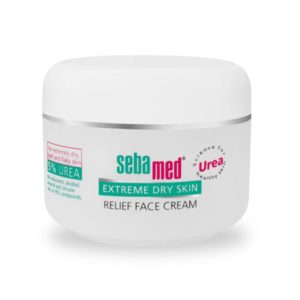
Water (Aqua), Caprylic/Capric Triglyceride, Urea, Glycerin, Tocopheryl Acetate, Glyceryl Stearate, Panthenol, Cetearyl Alcohol, Asiaticoside, Asiatic Acid, Madecassic Acid, Bisabolol, Sodium Carbomer, Parfum, Benzyl Alcohol, Phenoxyethanol, Sodium Benzoate
This is a cream that really aims to bring moisture back to the skin. A combination of glycerin and urea go to work as the primary moisturizing agents. Though there are no reviews for individuals using this specific cream to treat seborrheic dermatitis, it has been included here to demonstrate another possible avenue for barrier repair, urea.
Caprylic/capric triglyceride is primary occlusive, while the combination of asiaticoside, asiatic acid, and madecassic acid appears to be integrated as a means to improve collagen synthesis [35].
Urea for seborrheic dermatitis
Urea is another important component of the skin’s moisture barrier and often used to treat excessively dry skin [36]. A study examining the effects of cream containing urea, lactic acid and propylene glycol demonstrated “meaningful improvements” [37] and urea has been shown to reduce epidermal hyperproliferation (commonly seen in seborrheic dermatitis [38]) [39].
Though the preservative system makes attempts at being acceptable by using a combination of benzyl alcohol, phenoxyethanol, sodium benzoate, some reports exist for phenoxyethanol acting as a possible irritant [40]. Similar to the Gold Bond above, the addition of perfume (fragrance) is questionable.
In the end, even if you don’t find much use from this specific cream, it may be worthwhile to investigate alternative urea-containing creams. And if you have any first-hand experience with the usage of urea, please share considering leaving your review in the comments section of this article.
Alternative Urea Creams for Seborrheic Dermatitis
Though the Epiceram described above use a proprietary active ingredient, the majority of barrier repair creams appear to utilize dimethicone as the primary barrier support agent.
Some other creams prescribed for atopic dermatitis include:
- Eucerin Smoothing Face Cream 5% Urea
Aqua, Urea, Glycerin, Caprylic/Capric Triglyceride, Cyclomethicone, Dimethicone, Pentaerythrityl Tetraisostearate, Triisostearin, Cetyl Alcohol, Sodium Lactate, Glyceryl Stearate, Benzyl Alcohol, PEG-40 Stearate, Biosaccharide Gum-1, Methylparaben, Lactic Acid, Lanolin Alcohol, Phenoxyethanol - Udderly Smooth Extra Care Cream 10% Urea
Active Ingredient: Urea 10% (Keratolytic). Inactive ingredients: Aqua, Stearic Acid, Peg-2 Stearate, Propylene Glycol, Isopropyl Myristate, Dimethicone, Lanolin Oil, Paraffinum Liquidum, Triethanolamine, Allantoin, Methylparaben, Propylparaben
EpiCeram Skin Barrier Emulsion Prescription Barrier Repair Cream for Seborrheic Dermatitis
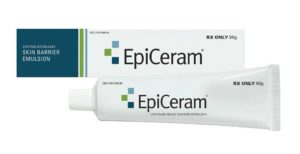
Purified Water, MultiSal™ Neolipids¹, Glyceryl Stearate, Squalane, Glycerin, PEG-100 Stearate, Hydroxypropyl Bispalmitamide MEA (Ceramide), Petrolatum, Dimethicone, Phenoxyethanol, Cholesterol, Conjugated Linoleic Acid, Citric Acid, Palmitic Acid, Xanthan Gum, Potassium Hydroxide, Disodium EDTA, Sorbic Acid, Capric Acid. ¹Proprietary microencapsulation system for gradual delivery of key ingredients including Ceramide, CLA, Cholesterol and Palmitic Acid (Formulated with E.Cerifera (Candelilla) wax, corn syrup solids, and modified food starch).
EpiCeram is a cream designed for the treatment of atopic dermatitis (eczema). Though it does not have any literature suggesting it’s usage for the treatment of seborrheic dermatitis, it’s benefit on skin barrier function may prove relevant.
Unfortunately, the availability (prescription is likely required) and cost of this cream make it a poor choice for many. Its inclusion here was to simply highlight the possible choices that one may have when looking for something to improve barrier function.
Other Possible Prescription Barrier Repair Creams for Seborrheic Dermatitis
Though the Epiceram described above use a proprietary active ingredient, the majority of barrier repair creams appear to utilize dimethicone as the primary barrier support agent.
Some other creams prescribed for atopic dermatitis include:
- 3M Cavilon Durable Barrier
Active Ingredients: Dimethicone 1.3% (Skin Protectant). Inactivate Ingredients: Water (Aqua), Diisooctyl Adipate, Cocos Nucifera (Coconut) Oil, PPG-15 Stearyl Ether, Dipropylene Glycol, Isopropyl Palmitrate, Mineral Oil (Paraffinum Liquidum), Ethylene/Acrylic Acid Copolymer, Acrylate Terpolymer, Paraffin, Magnesium Sulfate, Propylene Glycol, Fragance, Diazolidinyl Urea, Methylparaben, Propylparaben - Kendall Moisture Barrier
Active Ingredient: Dimethicone 5%. Inactive ingredients: Water, Simmondsia Chinensis (jojoba) Seed Oil, Zea Mays (corn) Starch, Cetearyl Alcohol, Glyceryl Stearate, Cirtus Aurantium Bergamia (bergamot) Fruit Oil, Citrus Medica Vulgaris Peel Oil, Sodium Stearoyl Lactylate, Retinyl Palmitate, Tocopheryl Acetate, Isopropyl Palmitate, Propylene Glycol, Triethanolamine, Sodium Pca, Carbopol, Butyrospermum Parkii (shea Butter), Phenoxyethanol, Methylparaben, Butylparaben, Propylparaben, Isobutylparaben, Ethylparaben
Common Creams That May Be Effective
In addition to targeted creams, there are options that don’t really fall into the two specific categories. These creams have been suggested by other community members of the website or by readers in the comments section of the various articles.
The benefit these creams provide is likely related to their moisturizing ability and general assistance in skin barrier maintenance.
The biggest benefit from this category is the fact that they are typically less expensive and easier to obtain than any of the options above. This is because they have been produced to be “mass market” creams that are to be used for general skin care. With this focus on volume, they need to be affordable and accessible.
Eau Thermale Avène Skin Recovery Cream Preservative Free Cream for Seborrheic Dermatitis
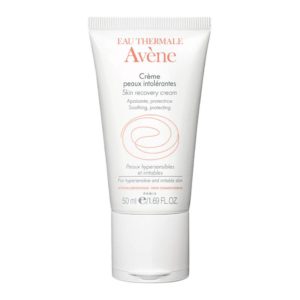
Avène Thermal Spring Water, Mineral Oil, Glycerin, Glyceryl Stearate, Squalane, Cyclopentasiloxane, Clycohexasiloxane, Serine, Carbomer, Tetrasodium Edta, Triethanolamine
This a minimal formula skin repair cream from Avène. In my opinion, the ingredients list is a good representation of using only the ingredients required and nothing more.
There are numerous patents for the use of thermal mineral water for the treatment of various skin conditions. It appears the trace minerals and acidity of the certain mineral water make it an excellent choice for regulating the skin pH gradient and reducing microbial activity [41].
Usage of mineral oil as the primary occlusive reduce the chance of irritation and glycerin is a straightforward humectant choice. The addition of squalane and serine are likely to provide some functional properties and benefit skin healing [42]
One of the main highlights of this formula is the lack of a dedicate preservative. Instead, Avène notes a strict manufacturing environment and patented packing technology (ensuring one-way flow of the cream) allow the ingredients to stay naturally germ-free. For those trying to avoid preservatives, this is can be a big plus.
Simple Kind to Skin Facial Moisturizer Low-Cost Moisturizer for Seborrheic Dermatitis
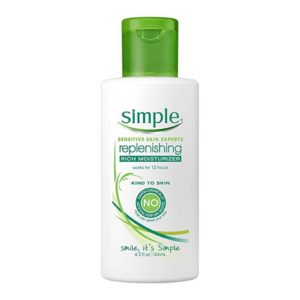
Water (Aqua, Eau), Caprylic/Capric Triglyceride, Glycerin, Polyglyceryl-3 Methyl Glucose Distearate, Stearyl Alcohol, Panthenol, Polyacrylamide, Stearic Acid, C13-14 Isoparaffin, Caprylyl Glycol, Laureth-7, Allantoin, Pentylene Glycol, Bisabolol, Disodium Edta, Lactic Acid, Sodium Lactate, Serine, Sodium Hydroxide, Urea, Sorbitol, Sodium Chloride, Citric Acid, Methylisothiazolinone, Phenoxyethanol.
First submitted by a reader, this moisturizer is a good representation of a basic moisturizer that may be beneficial for seborrheic dermatitis. The formula features various proven skin-friendly ingredients and does so at a very fair price.
Many of the ingredients of this formula have already been discussed earlier. Caprylic/Capric triglycerides and stearic acid are the primary occlusives, with glycerin, allantoin, panthenol, urea, and sodium lactate providing added moisturization function.
The preservative system used is the biggest downfall of this moisturizer. Caprylyl glycol appears first (known to be a fairly mild preservative choice) and its ability is then supplemented by phenoxyethanol (commonly used in tandem with caprylyl glycol). This itself may be a fair choice. however, the addition of methylisothiazolinone it where things fall apart. Methylisothiazolinone appears to be a fairly common problem for individuals with sensitive skin and its usage has come into question in recent years [43].
Overall, though it’s hard for this cream to compete with some of the options presented earlier, it’s inclusion represents the potential for unexpected options to provide significant relief. Reminding readers to never give up and to keep experimenting until they find what works for them.
Eucerin Skin Calming Natural Oatmeal Enriched Creme (Blue Cap Formula) Colloidal Oatmeal Cream for Seborrheic Dermatitis
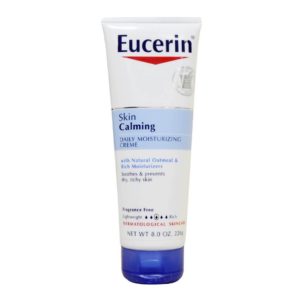
Blue Cap VersionWater, Glycerin, Cetyl Palmitate, Mineral Oil, Caprylic/Capric Triglyceride, Octyldodecanol, Cetyl Alcohol, Glyceryl Stearate, Colloidal Oatmeal, Dimethicone, PEG-40 Stearate, Carbomer, Sodium Hydroxide, Phenoxyethanol, Benzyl Alcohol, DMDM Hydantoin, Methylparaben, Ethylparaben
Eucerin is a well-known maker of highly hydrating creams which are well marketed and well received by dermatologists. This specific formula is aimed to calm the skin and restore moisture and has one of the biggest followings.
In my time with this website, there have been numerous readers who have recommended this formula marked success in off-label usage for seborrheic dermatitis. If you search around online, you will find similar feedback scattered around as well.
The formula is well rounded and has many of the usual suspects already discussed. Mineral oil, caprylic/capric triglycerides and octyldodecanol are the primary occlusives, while glycerin and colloidal oatmeal provide added moisturization.
Colloidal oatmeal formulations are popular for atopic dermatitis
Topical application of finely ground oatmeal has been shown to possess moisturizing, protective, anti-inflammatory, antioxidant, soothing, buffering, and cleansing properties [44]. Its effectiveness in eczema treatment is widely accepted, however, it’s usage for seborrheic dermatitis remains unexplored.
The preservative choices of parabens are considered poor by many seeking paraben free cosmetics.
Eucerin has listened to the consumer demand for paraben free skin care and introduced a paraben free version of the cream in a new red cap label bottle. Unfortunately, many long-time users have reported the new formula to be ineffective and not comparable to the original one.
What jumped out at me the most from the new formula was the presence of piroctone olamine (a popular anti-fungal option for seborrheic dermatitis treatment). It looks like the makers decided to use this together with benzyl alcohol to replace the previous preservative system.
Though many long-term users are unhappy with the new formula, the change in the preservative system may actually be welcome with those whose primary aim is to treat seborrheic dermatitis.
Other Colloidal Oatmeal Creams for Off-Label Seborrheic Dermatitis Treatment
Due to the popularity of colloidal oatmeal for treatment of eczema, a variety of options are available from other brands as well. This includes:
- Aveeno Baby Eczema Therapy Moisturizing Cream
Active Ingredients: Colloidal Oatmeal 1 % (Skin Protectant). Inactivate Ingredients: Water, Glycerin, Panthenol, Distearyldimonium Chloride, Petrolatum, Isopropyl Palmitate, Cetyl Alcohol, Dimethicone, Avena Sativa Kernel Oil, Benzalkonium Chloride, Ceramide NP, Sodium Chloride, Steareth-20 (Oat), Avena Sativa Kernel Extract (Oat) - La Roche-Posay Lipikar Eczema Cream Soothing Relief Cream
Active Ingredient: Colloidal Oatmeal 1% (Skin Protectant). Inactive ingredients: Water, Shea Butter, Glycerin, Dimethicone, Mineral Oil, Niacinamide, Cetearyl Alcohol, Rapeseed Seed Oil, Ammonium Polyacryloyldimethyl Taurate, PEG-100 Stearate, Glyceryl Stearate, Tocopherol, Sodium Benzoate, PEG-20 Methyl Glucose Sesquistearate, Dimethiconol, Mannose, Xanthan Gum, Pentaerythrityl Tetra-Di-T-Butyl Hydroxyhydrocinnamate, Capryloyl Glycine, Microcrystalline Wax, Sorbitan Tristearate, Paraffin, Disodium EDTA, Vitreoscilla Ferment, Citric Acid
Overall Best Seborrheic Dermatitis Creams by Category
After examination of all the candidates, it’s time to review the scoreboard and identify the leaders in each category. But please keep in mind that the rating system used may not be perfect and some disagreement is likely to exist.
The comments section provides an opportunity for individuals to raise any questions, suggestions, or concerns they may have. On my part, will try to keep this post up-to-date and reflect any new information that emerges.
With this in mind, the following points should also be considered when formulating your decision:
- General feedback is used – the feedback score is a number that represents aggregate reviews regarding a product. This score is not solely for the effectiveness of the cream in its use for seborrheic dermatitis treatment.
- Targeted solutions increase the odds – the chance of success with a medicated cream is likely to be higher than that of a barrier repair cream due to specific formulation considerations; while only a fine line separates barrier repair creams and common moisturizers.
- Don’t forget about samples – sensitivities to certain ingredients are extremely hard to predict. Obtaining a large number of samples and spot testing different formulations may prove worthwhile.
Top Anti-fungal/Medicated Cream
First, let’s review medicated creams and see who comes out on top:
| Cream | Feedback | Formula | Cost | Availability | Overall¹ | Overall² |
|---|---|---|---|---|---|---|
| Noble Formula Zinc Pyrithione Cream | 4 | 3.5 | 4 | 3.5 | 11.5 | 15 |
| DermaZinc Zinc Pyrithione Cream | 4 | 3 | 4 | 3.5 | 11 | 14.5 |
| MG217 Psoriasis Treatment 2% Coal Tar Ointment | 4.5 | 4 | 4.5 | 3.5 | 13 | 16.5 |
| Sebclair Dermatola Cream (Promiseb Topical Cream) | 4.5 | 4.5 | 4 | 2 | 13 | 15 |
| Family Care Clotrimazole Anti-Fungal Cream | 4.5 | 3 | 4.5 | 3.5 | 12 | 15.5 |
| Curad Silver Solution Antimicrobial Gel | 5 | 4.5 | 3.5 | 4 | 13 | 17 |
| The Ordinary Azelaic Acid Suspension | 4 | 3.5 | 3.5 | 3.5 | 11 | 14.5 |
¹ Does not take into account availability
Out of the medicated seborrheic dermatitis creams, three options squeeze out ahead based on feedback, ingredients, and cost. Totaling in at 13 points each these creams are:
- MG217 Psoriasis Treatment 2% Coal Tar Ointment
- Sebclair Dermatola Cream (Promiseb Topical Cream)
- Curad Silver Solution Antimicrobial Gel
Now if we throw availability into the rating mix, the positions shift around and a more clear leaderboard emerges:
- Curad Silver Solution Antimicrobial Gel
- MG217 Psoriasis Treatment 2% Coal Tar Ointment
- Family Care Clotrimazole Anti-Fungal Cream
Being a prescription cream, Sebclair (Promiseb) falls behind and moves to fourth place, while the Family Care Clotrimazole cream sneaking into third place.
In the end, though silver nanoparticles may not be the most common treatment for seborrheic dermatitis, the Curad Silver Solution Antimicrobial Gel emerges as the winner in this category; in big part, thanks to its minimal ingredients list and high aggregate feedback score.
If you feel that this cream should not be the winner please voice your opinion in the comments section. I’m open to input and adjusting this article as necessary.
Top Barrier Repair Cream
Moving on the barrier repair creams, we see much more variation in score:
| Cream | Feedback | Formula | Cost | Availability | Overall¹ | Overall² |
|---|---|---|---|---|---|---|
| Cetaphil Pro Eczema Soothing Moisturizer | 4.5 | 5 | 4 | 5 | 13.5 | 18.5 |
| Gold Bond Ultimate Healing Skin Therapy Lotion | 4.5 | 3.5 | 4.5 | 5 | 12.5 | 17.5 |
| Sebamed Extreme Dry Skin Relief Face Cream 5% Urea | 3.5 | 4 | 3.5 | 4.5 | 11 | 15.5 |
| EpiCeram Skin Barrier Emulsion | 4 | 4.5 | 3.5 | 2 | 12 | 14 |
¹ Does not take into account availability
Whether or not we take availability into consideration, the Cetaphil Pro edges out the top spot. This all boils down to a fairly clean and simple ingredients list which utilizes one of the more safer preservative systems, high overall feedback score, excellent availability, and all at a fair price.
If you disagree with the above rating or have any other suggestions, please feel free to drop a comment below. Again, I’m open to making adjustments if necessary.
Prescription barrier repair creams
For individuals seeking more advanced options no matter the cost, discussing a prescription strength barrier repair cream with a dermatologist may also be a viable path to consider. However, as noted in earlier in the next, over the counter options are often just as good [34].
Top Common Cream
Last, but not least, here is a breakdown of how the common creams stack up:
| Cream | Feedback | Formula | Cost | Availability | Overall¹ | Overall² |
|---|---|---|---|---|---|---|
| Eau Thermale Avène Skin Recovery Cream | 5 | 4.5 | 3.5 | 4 | 13 | 17 |
| Simple Kind to Skin Facial Moisturizer | 4 | 3.5 | 4.5 | 5 | 12 | 17 |
| Eucerin Skin Calming (Blue Cap Formula) | 5 | 3.5 | 5 | 4.5 | 13.5 | 18 |
¹ Does not take into account availability
Despite its aggressive preservative system, the Eucerin Skin Calming pulls ahead thanks to its strong user feedback score and low cost. The Avène Skin Recovery Cream is a close second and if the price is of no concern, this may actually be the preferred choice solely based on it’s simple and preservative-free formulation.
Summary
This article has covered a lot of ground and hopefully provided you the information you need to find the right cream for your seborrheic dermatitis issues.
Key points include:
- Though disagreement exists, seborrheic dermatitis is commonly believed to be caused by the skin’s reaction to the oleic free fatty acids produced by the Malassezia yeasts interaction with our sebum
- Creams primarily depend on a combination of ingredients that provide moisture retaining, anti-oxidant, and anti-inflammatory properties to restore hydration and eliminate redness
- Medicated seborrheic dermatitis creams aim to reduce the amount of Malassezia activity and eradicate the presence of oleic free fatty acids (some options can improve barrier function as well)
- Skin barrier repair formulations and common moisturizers are primarily designed to improve the skin’s natural defense system and may minimize the irritant potential of oleic free fatty acids
- Psoriasis aimed MG217 2% Coal Tar Ointment, Curad Silver Solution Antimicrobial Gel, and Promiseb Topical Cream are all tied for first place in the medicated cream category
- If availability is considered, the Curad Silver Solution Antimicrobial Gel comes out as the winner (from medicated category), thanks to its minimal formula, fair cost, and widespread availability
- If cost is not an issue and you’re able to obtain a prescription for it, the Promiseb Topical Cream may be a good choice as it contains a variety of barrier supporting ingredients
- The Cetaphil Pro Eczema Soothing Moisturizer takes a decisive victory amongst the barrier repair creams due in big part to its skin-friendly formula and this option has gained strong support on this website
- The Eucerin Skin Calming (Blue Cap Formula) cream edges out a win in the common creams category despite its questionable preservative system; if cost is not an issue, the Eau Thermale Avène Skin Recovery Cream will be the best choice
In the end, it’s been a pleasure preparing this article.
Hopefully, you found some relevant insight and more importantly find success with one of the formulations reviewed here. If you have any suggestions, questions, or know of an effective seborrheic dermatitis cream that was missed, please drop a comment below. On my part, will try to keep this post up to date with any information that surfaces.
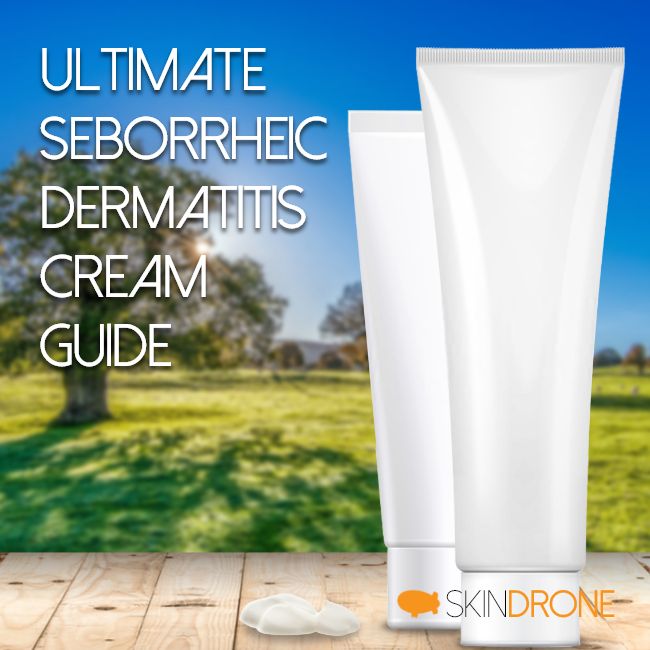

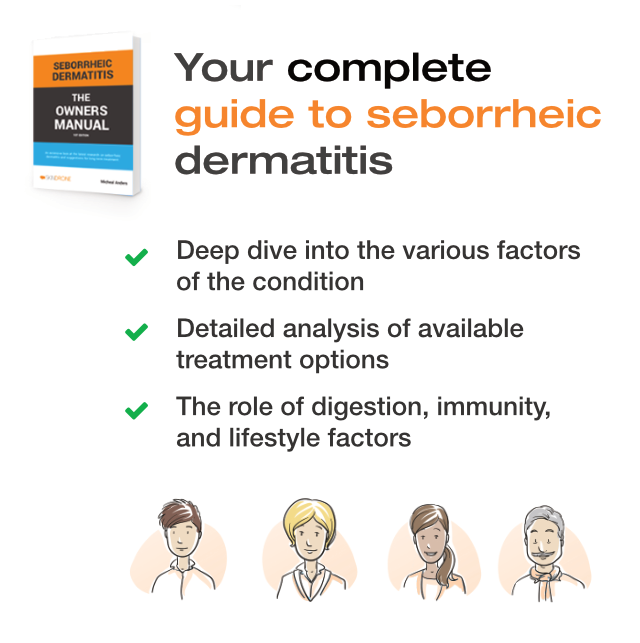
Hi again! I have found an acne cream that helps with stubborn breakouts of SDand my Rosacea! Yes, it will turn the skin pink but it does not burn like much of the acne products! It is called Alba Botanical, Asne dote Oil Control Lotion. I also like Cerave PM lotion for faces and Cerave Moisture Cream for softening scalp scales etc. No luck with the Gold Bond Ultimate Psoriasis (pricey too) but TriDerma Psoriasis is a wee better than Gold Bond. My RX for Ketaconzole Foam failed big time and so did a sample of Soolantra from my Dermatologist. I am willing to try ANYTHING and am now using ACV inside and out along with Olive Oil, Coconut Oil and Seabuck Thorn Oil individually and spaced a week apart. Thanks for your insight and work!! Lee
Reply PermalinkWhich of the creams or barriers can be used on eyelids wit sebhorrea dermatitis. otherwise what can be used on a chronic type on eyelids?
Reply PermalinkReally helpful, just trying to digest it all, such a big subject. The way you have compiled the info is excellent, thankyou!
Reply PermalinkDear Christine,
Thank you for the kind comment!
Glad to hear the article proved a relavent read.
Really wish there were more answers out there for us.
All the best!
Reply PermalinkDear Phyllis,
Thanks for taking the time to write.
From my experience, application in and around the eye is really quite tricky.
Not sure if you’ve come across it yet, but an earlier post dedicated specifically to treating seborrheic dermatitis on the eyelids was discussed in a previous post:
On the first attempt, going with something more mild like the baking soda compresses or saline rinses may be worth a try. However, in regards to anti-fungal or medicated solutions, it’s probably best to consult with a local pharmacist or doctor. Perhaps prescribe/formulate a dedicated formula specifically for use in this sensitive area.
In any case, if you still have questions beyond the post linked above, let me know.
Wish you all the best and hope you see some progress!
Reply PermalinkThanks, Michael.
Reply PermalinkYour detailed research is helping many!!
Wow, I really did not expect such a in depth article following a clear, well thought-out methodology to judge the products. Clearly, the author is a researcher himself or at least has done a lot of research. Thank you for the information, Michael. Now I know which cream I am going to get for myself.
Reply PermalinkI can’t choose between the MG217 or the Curad Silver? Which one would be a better choose in terms of effectiveness?
Reply PermalinkHi Fanne,
Hard to say as we all respond a little different. Coal tar (the active ingredient in the MG217) definetly seems to have more research supporting it’s usage for malassezia related skin issues such as seborrheic dermatitis.
On the other hand, silver chloride (the active in the Curad) may be more then sufficient, while also likely to have better all around usability (it isn’t as thick and should be much lighter).
Personally, would probably first try one of the over the counter barrier repair solutions and see how that goes. It’s easy to underestimate the importance of stable barrier function in these issues.
Reply Permalinkhi,
Reply Permalinksorry i speak only french so i will writte in french
Je voudrais savoir Michael si sa serais possible de traduire le manuel de la dermatite séborrhéique en français ? Moi je suis du Québec et a seulement 20 ans j’ai beaucoup de rougeur sur le visage et cela a empirer depuis plusieurs moi, je ne sais plus quoi faire, j’ai commandé votre produit et je suis impatient de la tester ces’t mon dernier espoirs, je peut même plus sortir a l’extérieure tellement que mon visage et rouge et je suis constamment en dépression a cause de cette maladie qui me ruine littéralement, je vais plus a l’école a cause de ça et j’ai cessé de travailler parce que j’étais constamment en dépression.
Hi, Michael,
I was wondering if you had tried/tested any of the CeraVe line of creams and products.
The dermatologist recommended CeraVe itch relief cream for my excema and it seems to help with itching. Supposed
Y the whole line was developed by dermatologists, so I thought maybe they had come up with something for seborrheic dermatitis. I’m still using Biom8 and I love it, but I’m still plagued by on/off itching. It seems to come and go. Very annoying.
Thanks for any advice and suggestions, Michael.
Marie Andree
Reply Permalink